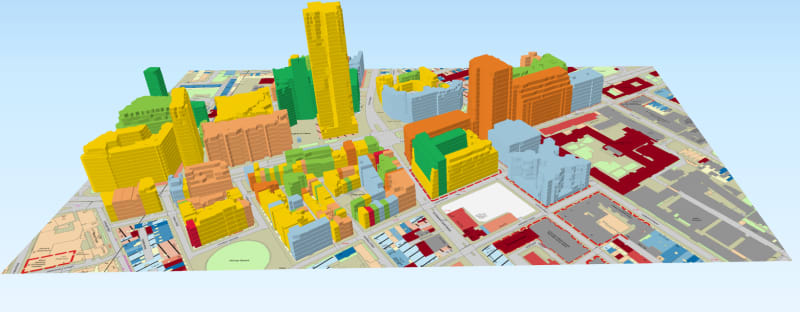3DStock

This is a long-term project on modelling building stocks and their use of energy, supported by a series of grants and consultancies from the Engineering and Physical Sciences Research Council (EPSRC), the multi-university Centre for Research in Energy Demand Solutions (CREDS), the Greater London Authority, and a series of UK government energy departments. The work has been carried out by Stephen Evans, Rob Liddiard, Daniel Godoy-Shimizu, Dominic Humphrey and myself, with other members of the Building Stock Laboratory at the UCL Energy Institute.
3DStock is a method for constructing digital models of all buildings – domestic, non-domestic and mixed-use – in a locality, in three dimensions and located geographically. The primary purpose is the analysis of energy performance, but there are many other potential applications. Models have been built of Greater London and the towns and cities of Leicester, Swindon, Tamworth and Milton Keynes. More recently the modelling has been extended to the whole of England, Wales and Scotland.
The models are assembled automatically from Ordnance Survey digital maps, commercial rating data from the Valuation Office agency (VOA), LiDAR data (laser measurements made by overflying aircraft) from the Environment Agency, and several other sources. Activities are recorded in detail, floor by floor and in many instances down to the room level. Special attention is devoted to the complex relationships between premises and buildings. Floor areas are given by the VOA data, or are otherwise estimated from the external geometry of buildings. Actual metered energy data are attached at the premises/ building level where these are available, as in Display Energy Certificates; or aggregated to postcodes, LSOs or larger areal units. Energy Performance Certificates are also attached to premises and buildings. Geometry and activity data can be passed from 3DStock to a second model, SimStock, with which future energy performance can be predicted using dynamic simulation, for large populations of buildings.
3DStock has been used to date in a series of projects for the Department of Energy and Climate Change and the Department for Business, Energy and Industrial Strategy, including the evaluation of several government energy efficiency programmes, and studies of the potential uptake of building-based renewable energy technologies in connection with setting the Fifth Carbon Budget. Our team are currently working for the Department of Energy Security and Net Zero on a model of all buildings in England, Wales and Scotland. This will be completed in 2025 and used by the Department for setting policy on decarbonisation of the stock.
3DStock has also been used in a number of scientific studies of the relation of energy use to density and built form, including a project funded by EPSRC: ‘High-Rise Buildings: Energy and Density’, an investigation of the relationship between height and energy use in office buildings (described in a separate item).